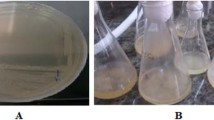Abstract
The application of bacterial cellulose as a dressing for chronic and burn wounds has been described as beneficial for healing. However, this study and other tests have shown that bacterial cellulose has no significant influence on the biochemical state of chronic wounds. Such wounds persist in the inflammatory phase of the normal healing process and fail to heal. Exudates from non-healing wounds show elevated levels of proteolytic enzymes, cytokines and reactive oxygen species (ROS), leading to a reduced concentration of growth factors and proteinase inhibitors and to a degradation of tissue and severe damage. Thus, the reduction of protein degrading enzymes and proinflammatory interleukins as well as scavenging of ROS appears to be a suitable way to support the healing process. The aim of the present study was to improve the positive features of bacterial cellulose as wound dressing by incorporation of collagen type I into the cellulose pellicle. The research focussed on the possible in situ formation of a composite of bacterial cellulose and collagen type I. This biomaterial is able to reduce the amount of selected proteases and interleukins significantly and possesses a distinct antioxidant capacity as well.
Similar content being viewed by others
Abbreviations
- MMPs:
-
matrix metalloproteases
- ORC:
-
oxidized regenerated cellulose
- PMN granulocytes:
-
polymorphonuclear granulocytes
- ROS:
-
reactive oxygen species
References
Barrick B., Campbell E.J., Owen C.A. (1999) Leukocyte proteinases in wound healing: roles in physiologic and pathologic processes. Wound Rep. Reg. 7:410–422
Beckman J.S., Beckman T.W., Chen J., Marshall P.A., Freeman B.A. (1990) Apparent hydroxyl radical production by peroxynitrite: Implications for endothelial injury from nitric oxide and superoxide. Proc. Natl. Acad. Sci. USA 87(4):1620–1624
Boekenkamp D., Hempel J.C. and Hoppe H.U. 2002. Microbially produced, physiologically compatible, permeable film compromised of cellulose that contains chitosan. DE10064314
Borzani W., De Souza S.J. (1995) Mechanism of the film thickness increasing during bacterial production of cellulose in non-agitated liquid media. Biotechnol. Lett. 17(11):1271–1272
Brown A.J. (1886) An acetic ferment which forms cellulose. J. Chem. Soc. (London). 49:432–439
Cullen B., Smith R., MCCulloch E., Silcock D., Morrison L. (2002) Mechanism of action of PROMOGRAN, a protease modulationg matrix, for the treatment of diabetic foot ulcers. Wound Rep. Reg. 10:16–25
Dobb M.G., Hamlyn P.F., Crighton J. and Tasker A. 1998. Cellulose Products. GB2314856
Fontana J.D., DeSouza A.M., Fontana C.K., Torriani I.L., Moreschi J.C., Gallotti B.J., DeSouza S.J., Narcisco G.P., Bichara J.A., Farah L.F.X. (1990) Acetobacter cellulose pellicle as a temporary skin substitute. Appl. Biochem. Biotechnol. 24–25:253–264
Frankenfeldt K., Hornung M., Lindner B., Ludwig M., Muelverstedt A. and Schmauder H.-P. 2001. Preparing bacterial cellulose from Acetobacter xylinum, useful for making medical or cosmetic pads, comprises culturing in buffered medium with easy purification under mild conditions. DE 10022751
Friess W. (1998) Collagen – biomaterial for drug delivery. Eur. J. Pharm. Biopharm. 45:113–136
Herold S., Koppenol W.H. (2001) Living in an oxygen atmosphere – NO problem? Chimia 55:870–874
Herrick S., Ashcroft G., Ireland G., Horan M., McCollum Ch., Ferguson M. (1997) Up-regulation of elastase in acute wounds of healthy aged humans and chronic venous leg ulcers are associated with matrix degradation. Lab. Invest. 77:281–288
Jonas R., Farah L.F. (1998) Production and application of microbial cellulose. Poly. Deg. Stab. 59:101–106
Krystynowicz A., Czaja W., Pomorski L., Kolodziejczyk M., Bielecki S. (2000) The evaluation of usefulness of microbial cellulose as a wound dressing material. Med. Fac. Landbouw. Univ. Gent. 65(3a):213–220
Lentz K.E., Koehler K.P., Mormino R., Oster G.A. and Serafina G. 2003. Microbial cellulose wound dressing for treating chronic wounds. EP1356831
Mast B.A., Schultz G.S. (1996) Interactions of cytokines, growth factors, and proteases in acute and chronic wounds. Wound Rep. Reg. 4:411–420
Moseley R., Walker M., Waddington R.J., Chen W.Y.J. (2003) Comparison of the antioxidant properties of wound dressing materials – carboxymethylcellulose, hyaluronan benzyl ester and hyaluronan, towards polymorphneclear leukocyte-derived reactive oxygen species. Biomaterials 24:1549–1557
Nwomeh B.C., Yager D.R., Cohen I.K. (1998) Physiology of the chronic wound. Clin. Plast. Surg. 25(3):341–356
Ovington L., Cullen B. (2002) Matrix metalloproteinases modulation and growth factor protection. Wounds 14(5)Suppl:3–13
Rebello C., Almeida D.A.D., Lima E.M. Jr., Dornelas M.D.P. (1987) Biofill a new skin substitute: our experience. Rev. Bras. Cir. 77(6):407–414
Ring D.F., Nashed W. and Dow T.H. 1986. Liquid loaded pad for medical applications. US4588400
Rojkind M., Dominguez-Rosales J.-A., Nieto N., Greenwel P. (2002) Role of hydrogen peroxide and oxidative stress in healing responses. Cell. Mol. Life Sci. 59:1872–1891
Schönfelder U., Abel M., Wiegand C., Klemm D., Elsner P., Hipler U.C. (2005) Influence of selected wound dressings on PMN elastase in chronic wound fluid and their antioxidative potential in vitro. Biomaterials 26: 6664–6673
Schramm M., Hestrin S. (1954) Factors affecting production of cellulose at the air/liquid interface of a culture of Acetobacter xylinum. J. Gen. Microbiol. 11:123–129
Schultz G.S., Mast B.A. (1998) Molecular analysis of the environment of healing and chronic wounds: cytokines, proteases and growth factors. Wounds 10(SupplF):1F–9F
Serafica G., Mormino R., Bungay H. (2002) Inclusion of solid particles in bacterial cellulose. Appl. Microbiol. Biotechnol. 58:756–760
Trengove N.J., Stacey M.C., Macauley S., Bennett N., Gibson J., Burslem F., Murphy G., Schultz G. (1999) Analysis of the acute and chronic wound environments: the role of proteases and their inhibitors. Wound. Rep. Reg. 7:442–52
Walker M., Hobot J.A., Newman G.R., Bowler P.G. (2003) Scanning electron microscopic examination of bacterial immobilisation in a carboxymethyl cellulose (AQUACEL) and alginate dressings. Biomaterials 24:883–890
Waring M.J., Parsons D. (2001) Physico-chemical characterisation of carboxymethylated spun cellulose fibres. Biomaterials 22:903–912
Yager D.R., Nwomeh B.C. (1999) The proteolytic environment of the chronic wounds. Wound Rep. Reg. 7:433–441
Yamanaka S., Ono E., Watanabe O., Kusakabe M. and Suzuki, Y. 1990. Hollow microbial cellulose, process for preparation thereof, and artificial blood vessels formed of said cellulose. EP0396344
Author information
Authors and Affiliations
Corresponding author
Rights and permissions
About this article
Cite this article
Wiegand, C., Elsner, P., Hipler, UC. et al. Protease and ROS activities influenced by a composite of bacterial cellulose and collagen type I in vitro . Cellulose 13, 689–696 (2006). https://doi.org/10.1007/s10570-006-9073-0
Received:
Accepted:
Published:
Issue Date:
DOI: https://doi.org/10.1007/s10570-006-9073-0




